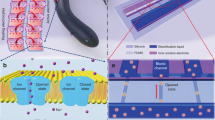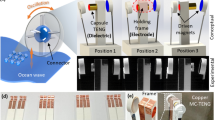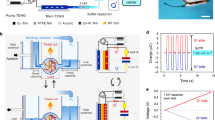Abstract
Improved methods are needed for harvesting mechanical energy. Coiled carbon nanotube yarns, termed twistrons, use stretch-induced changes in electrochemical capacitance to convert mechanical energy to electricity. Elongation of the yarn produces such large lateral Poisson’s ratios that the yarns are highly stretch densified, which contributes to harvesting. Here we report plied twistrons, instead of coiled, which increase the energy conversion efficiency of the yarns from 7.6% to 17.4% for stretch and to 22.4% for twist. This is attributed to additional harvesting mechanisms by yarn stretch and lateral deformations. For harvesting between 2 and 120 Hz, our plied twistron has higher gravimetric peak power and average power than has been reported for non-twistron, material-based mechanical energy harvesters. We sew the twistrons into textiles for sensing and harvesting human motion, deploy them in salt water for harvesting ocean wave energy and use them to charge supercapacitors.
This is a preview of subscription content, access via your institution
Access options
Access Nature and 54 other Nature Portfolio journals
Get Nature+, our best-value online-access subscription
$29.99 / 30 days
cancel any time
Subscribe to this journal
Receive 12 digital issues and online access to articles
$119.00 per year
only $9.92 per issue
Buy this article
- Purchase on Springer Link
- Instant access to full article PDF
Prices may be subject to local taxes which are calculated during checkout




Similar content being viewed by others
Data availability
All of the data generated in this study are included in the published Article and its Supplementary Information.
References
Zi, Y. et al. Harvesting low-frequency (<5 Hz) irregular mechanical energy: a possible killer application of triboelectric nanogenerator. ACS Nano 10, 4797–4805 (2016).
Zhang, C., Tang, W., Han, C., Fan, F. & Wang, Z. L. Theoretical comparison, equivalent transformation, and conjunction operations of electromagnetic induction generator and triboelectric nanogenerator for harvesting mechanical energy. Adv. Mater. 26, 3580–3591 (2014).
Gabris, M. A. & Ping, J. Carbon nanomaterial-based nanogenerators for harvesting energy from environment. Nano Energy 90, 106494 (2021).
Xu, C., Song, Y., Han, M. & Zhang, H. Portable and wearable self-powered systems based on emerging energy harvesting technology. Microsyst. Nanoeng. 7, 25 (2021).
Li, Y. et al. Improved output performance of triboelectric nanogenerator by fast accumulation process of surface charges. Adv. Energy Mater. 11, 2100050 (2021).
Salauddin, M. et al. A novel MXene/Ecoflex nanocomposite-coated fabric as a highly negative and stable friction layer for high-output triboelectric nanogenerators. Adv. Energy Mater. 11, 2002832 (2021).
Gong, W. et al. Continuous and scalable manufacture of amphibious energy yarns and textiles. Nat. Commun. 10, 868 (2019).
Espinosa, H. D., Bernal, R. A. & Minary-Jolandan, M. A review of mechanical and electromechanical properties of piezoelectric nanowires. Adv. Mater. 24, 4656–4675 (2012).
Cha, S. et al. Porous PVDF as effective sonic wave driven nanogenerators. Nano Lett. 11, 5142–5147 (2011).
Jiang, Y. et al. Optimizing energy harvesting performance of cone dielectric elastomer generator based on VHB elastomer. Nano Energy 71, 104606 (2020).
Huang, J., Shian, S., Suo, Z. & Clarke, D. R. Maximizing the energy density of dielectric elastomer generators using equi-biaxial loading. Adv. Funct. Mater. 23, 5056–5061 (2013).
Zhang, M. et al. Self-powered, electrochemical carbon nanotube pressure sensors for wave monitoring. Adv. Funct. Mater. 30, 2004564 (2020).
Kim, S. H. et al. Harvesting electrical energy from carbon nanotube yarn twist. Science 357, 773–778 (2017).
Mun, T. J. et al. Wearable energy generating and storing textile based on carbon nanotube yarns. Adv. Funct. Mater. 30, 2000411 (2020).
Jang, Y. et al. Self-powered coiled carbon-nanotube yarn sensor for gastric electronics. ACS Sens. 4, 2893–2899 (2019).
Kim, S. et al. Electrochemically driven mechanical energy harvesting. Nat. Commun. 7, 10146 (2016).
Moon, J. K., Jeong, J., Lee, D. & Pak, H. K. Electrical power generation by mechanically modulating electrical double layers. Nat. Commun. 4, 1487 (2013).
Zhang, Y. et al. Micro electrostatic energy harvester with both broad bandwidth and high normalized power density. Appl. Energy 212, 362–371 (2018).
Xu, Y. et al. A one-dimensional fluidic nanogenerator with a high power conversion efficiency. Angew. Chem. Int. Ed. 56, 12940–12945 (2017).
Liu, J., Dai, L. & Baur, J. W. Multiwalled carbon nanotubes for flow-induced voltage generation. J. Appl. Phys. 101, 64312 (2007).
Zhang, Z. et al. Emerging hydrovoltaic technology. Nat. Nanotechnol. 13, 1109–1119 (2018).
Xue, G. et al. Water-evaporation-induced electricity with nanostructured carbon materials. Nat. Nanotechnol. 12, 317–321 (2017).
Li, M. et al. Gel-electrolyte-coated carbon nanotube yarns for self-powered and knittable piezoionic sensors. ACS Appl. Electron. Mater. 3, 944–954 (2021).
Wang, Z. et al. More powerful twistron carbon nanotube yarn mechanical energy harvesters. Adv. Mater. 34, 2201826 (2022).
Nurazzi, N. M. et al. Treatments of natural fiber as reinforcement in polymer composites—a short review. Funct. Compos. Struct. 3, 24002 (2021).
Jung, W. et al. High output piezo/triboelectric hybrid generator. Sci. Rep. 5, 9309 (2015).
Inoue, H. et al. The critical role of the forest morphology for dry drawability of few-walled carbon nanotubes. Carbon 158, 662–671 (2020).
Xu, M., Futaba, D. N., Yumura, M. & Hata, K. Alignment control of carbon nanotube forest from random to nearly perfectly aligned by utilizing the crowding effect. ACS Nano 6, 5837–5844 (2012).
Zhu, J. et al. The effect of various electrolyte cations on electrochemical performance of polypyrrole/RGO based supercapacitors. Phys. Chem. Chem. Phys. 17, 28666–28673 (2015).
Taylor, L. W. et al. Improved properties, increased production, and the path to broad adoption of carbon nanotube fibers. Carbon 171, 689–694 (2021).
Kang, M. G. et al. High power magnetic field energy harvesting through amplified magneto-mechanical vibration. Adv. Energy Mater. 8, 1703313 (2018).
Ye, C. et al. A triboelectric–electromagnetic hybrid nanogenerator with broadband working range for wind energy harvesting and a self-powered wind speed sensor. ACS Energy Lett. 6, 1443–1452 (2021).
Xie, Y. et al. Grating-structured freestanding triboelectric-layer nanogenerator for harvesting mechanical energy at 85% total conversion efficiency. Adv. Mater. 26, 6599–6607 (2014).
Zhang, M., Atkinson, K. R. & Baughman, R. H. Multifunctional carbon nanotube yarns by downsizing an ancient technology. Science 306, 1358–1361 (2004).
Baughman, R. H., Stafstrom, S., Cui, C. & Dantas, S. O. Materials with negative compressibilities in one or more dimensions. Science 279, 1522–1524 (1998).
Kong, J. et al. Temperature dependence of ion diffusion coefficients in NaCl electrolyte confined within graphene nanochannels. Phys. Chem. Chem. Phys. 19, 7678–7688 (2017).
Kim, D. et al. High-performance nanopattern triboelectric generator by block copolymer lithography. Nano Energy 12, 331–338 (2015).
Acknowledgements
Support in the United States was from Navy grants ONR/STTR N68335-18-C-0368 (R.H.B.) and ONR N00014-22-1-2569 (R.H.B.), Air Force Office of Scientific Research grants N68335-19C-0303 (R.H.B.) and FA9550-21-1-0455 (R.H.B.), Robert A. Welch Foundation grant AT-0029 (R.H.B.), National Science Foundation grant CMMI-1636306 (H.L.) and Department of Energy grant DE-NA0003962 (H.L.).
Author information
Authors and Affiliations
Contributions
M.Z. and R.H.B. conceived of and initiated the project. C.H. synthesized the CNT forests. M.Z., W.C., Z.W., S.F., A.E.A., A.A.Z., J.O., J.H.M., J.W.P. and S.J.K. fabricated the CNT yarns and measured their performance. M.Z., W.C., S.F. and C.H. characterized the microstructure of the CNT yarns. M.Z., W.C., S.F., R.Z., H.L., E.G. and R.H.B. conducted the X-ray tomography characterization. M.Z., W.C., Z.W., S.F., A.E.A. and R.H.B. demonstrated the applications of CNT yarns. All authors conducted the data analysis and prepared the manuscript.
Corresponding author
Ethics declarations
Competing interests
Z.W., R.H.B., M.Z., W.C., S.F., S.J.K. and J.H.M. are among the inventors of provisional US patent application number 63/235,023, submitted jointly by the Board of Regents, University of Texas System (for the University of Texas at Dallas) and Industry-University Cooperation Foundation of Hanyang University, which covers the design, fabrication, performance and applications of twistron mechanical energy harvesters. The remaining authors declare no competing interests.
Peer review
Peer review information
Nature Energy thanks Soo Jin Adrian Koh and the other, anonymous, reviewer(s) for their contribution to the peer review of this work.
Additional information
Publisher’s note Springer Nature remains neutral with regard to jurisdictional claims in published maps and institutional affiliations.
Supplementary information
Supplementary Information
Supplementary Figs. 1–61, Tables 1 and 2 and references 1–90.
Rights and permissions
Springer Nature or its licensor (e.g. a society or other partner) holds exclusive rights to this article under a publishing agreement with the author(s) or other rightsholder(s); author self-archiving of the accepted manuscript version of this article is solely governed by the terms of such publishing agreement and applicable law.
About this article
Cite this article
Zhang, M., Cai, W., Wang, Z. et al. Mechanical energy harvesters with tensile efficiency of 17.4% and torsional efficiency of 22.4% based on homochirally plied carbon nanotube yarns. Nat Energy 8, 203–213 (2023). https://doi.org/10.1038/s41560-022-01191-7
Received:
Accepted:
Published:
Issue Date:
DOI: https://doi.org/10.1038/s41560-022-01191-7
This article is cited by
-
Giant nanomechanical energy storage capacity in twisted single-walled carbon nanotube ropes
Nature Nanotechnology (2024)



